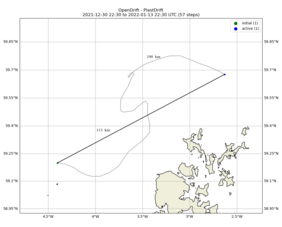"It was close to midnight on the second last night of the year 2021. A fishing vessel was heading towards Scrabster harbour in Northern Scotland to unload the catch of the day, so that the bounty of the sea would still make it to the Hogmanay (New Year's Eve) celebrations in the far North of Scotland and further away. But at 22.30 local time part of a fishing net had ripped apart as the net with the catch of the day had been reeled in. This rather large piece of net, about 2 meters wide and 3 meters long, broke away and started is' own journey on this fateful night on 30th of December, 2021..."
Abandoned and lost fishing nets, so called ghost nets, make up a significant part of the plastic pollution, which ends up in the seas worldwide. Ghost nets generally do not end up in the sea due to shortcomings of waste management or lack of bottle deposit systems, as is the case for many other types of plastic litter. The nets, which represent a significant financial outlay for fishers, have been made to sustain the hardships of fishing, to be dragged and soaked in sea for hundreds if not thousands of times. However, they are not immune to impacts of wear and tear, even these old sea dogs have their expiration date and cannot take everything. The nets can get tangled in obstacles, the plastic deteriorates over the time and under the stress pieces of net can be ripped apart. To help quantify the amount of fishing nets going to the sea, some jurisdictions have imposed strict rules. In Norway for instance, fishing vessels are required to report the location of lost nets to authorities, which allows potential efforts to recover them from the seabed or ocean.
This incident or case study in our plastics in the sea campaign originates close to Thurso, the northernmost town in Mainland Britain, where ous Scottish partner Environmental Research Institute is located. Scrabster is a busy, small harbour 2 km northwest of Thurso, and home port to a lively, small fleet of fishing vessels. The aim of this case study is to describe, where a piece of fishing net, which was lost on sea at 4.4. West and 59.2 North will end up. Norwegian Meteorological Institute will track and trace the journey of this hypothetical ghost net with the Open Drift Programme. The net was lost to the west to the Orkney Islands and is located now about two weeks later about 110 km away north of this island group. "The road "has not been straight, the total distance that the net has covered so far is almost 200 km. The net seems to be heading towards Shetland Islands, we will find out in 4 weeks on February the 10th, whether the net managed to bypass the Shetlands or did it beach there...
Next Friday we will head to the Baltic Sea and present our Turku case. Baltic Sea offers a different kind of stage for our Plastics in the sea campaign, when compared to the Atlantic. The Baltic Sea is a shallow sea, has low salitude and there is hardly any tidewater. A large part of the sea is also covered by ice during winter, which presents big challenges for year around maritime traffics...

